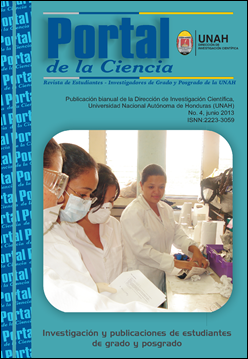Solid formulation based on Bacillus thuringiensis to control larvae of Aedes aegypti
DOI:
https://doi.org/10.5377/pc.v4i0.1860Keywords:
Dengue, Aedes aegypti, Bacillus thuringiensisAbstract
In the Central American region, more and more deaths are registered as a result of the incidences of both classic and hemorrhagic dengue. Honduras continues to be the most affected country with an incidence of 7,870 cases of dengue fever, 1798 cases of hemorrhagic dengue and 56 recorded deaths. Therefore an action to combat the mosquito Aedes aegypti has been developed, using the minimal amount of insecticides and selecting products with low toxicity to avoid environmental contamination. So it is necessary to develop an alternative to combat the larvae that leads to the proliferation of Aedes aegypti mosquito. Using techniques that are affordable for the population, the stage of eliminating the mosquito may be reached, through the development of a solid formula based on Bacillus thurigiensis, which achieves the mortality of the Aedes aegypti larvae. This bacteria produces proteins called Cry and Cyt or delta endotoxins, which are highly toxic to kill the Aedes aegypti larvae. These proteins do not pollute the environment because they are biodegradable and they do not damage any organism. In order to know the efficiency of this formula, lethal time and larval mortality were evaluated. According to the results, it can be concluded that the base formulation of Bacillus thuringiensis has a larvicidal effect, having a 72 hour lethal time and a 57% mortality rate of Aedes aegypti larvae.
DOI: http://dx.doi.org/10.5377/pc.v4i0.1860
Revista Portal de la Ciencia, No. 4, julio 2013: 38-44
Downloads
1744
Downloads
Published
How to Cite
Issue
Section
License
© Revista Portal de la Ciencia
Los autores/as que publiquen en esta revista aceptan las siguientes condiciones:
De acuerdo con la legislación de derechos de autor, Revista Portal de la Ciencia, reconoce y respeta el derecho moral de los autores, así como la titularidad del derecho patrimonial, el cual será cedido a la revista para su difusión en acceso abierto en versión impresa y en formato digital. Al formar parte de múltiples indexadores, bases de datos y sistemas de referencia, los artículos que sean publicados por Revista Portal de la Ciencia se encontrarán visibles y serán descargados también de estos sitios web, indicando, en todos los casos, la autoría de los artículos, la fecha de publicación y el número de la revista al que corresponden.

Este obra está bajo una licencia de Creative Commons Reconocimiento-NoComercial 4.0 Internacional.
Usted está en libertad de:
- Compartir: copiar y redistribuir el material en cualquier medio o formato
- Adaptar: remezclar, transformar y crear a partir del material
Bajo las siguientes condiciones:
- Reconocimiento: Usted debe darle crédito a esta obra de manera adecuada, proporcionando un enlace a la licencia, e indicando si se han realizado cambios. Puede hacerlo en cualquier forma razonable, pero no de forma tal que sugiera que usted o su uso tienen el apoyo del licenciante.
- Uso no comercial: Usted no puede hacer uso del material con fines comerciales.




